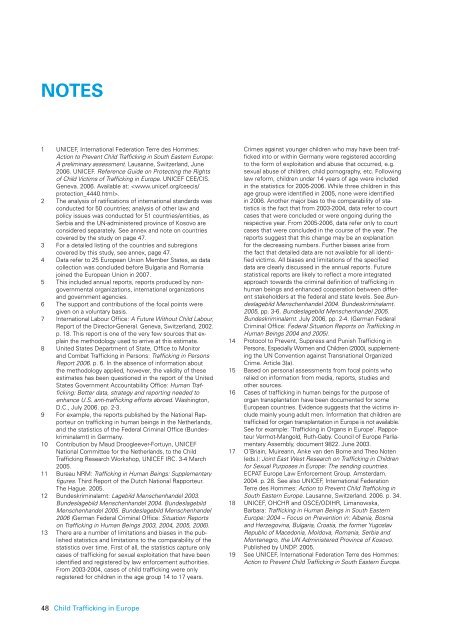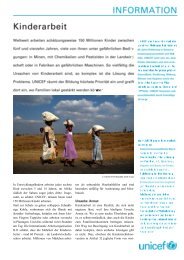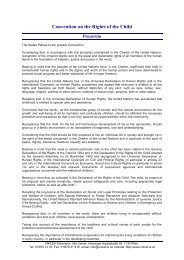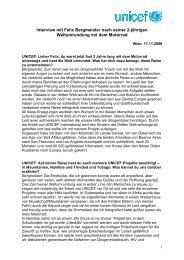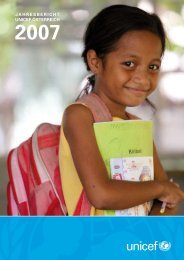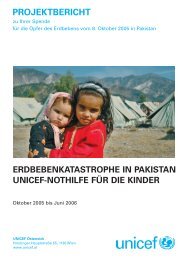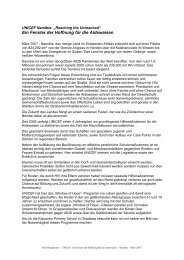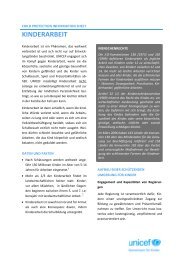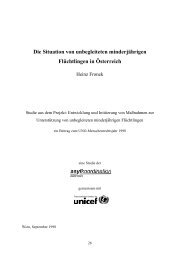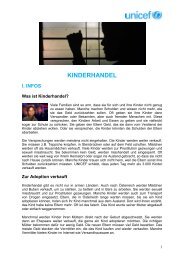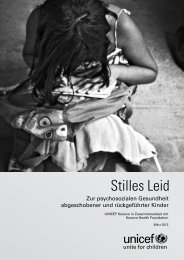Child Trafficking in Europe
Child Trafficking in Europe
Child Trafficking in Europe
You also want an ePaper? Increase the reach of your titles
YUMPU automatically turns print PDFs into web optimized ePapers that Google loves.
noTEs<br />
1 UNICEF, International Federation Terre des Hommes:<br />
Action to Prevent <strong>Child</strong> <strong>Traffick<strong>in</strong>g</strong> <strong>in</strong> South Eastern <strong>Europe</strong>:<br />
A prelim<strong>in</strong>ary assessment. Lausanne, Switzerland, June<br />
2006. UNICEF. Reference Guide on Protect<strong>in</strong>g the Rights<br />
of <strong>Child</strong> Victims of <strong>Traffick<strong>in</strong>g</strong> <strong>in</strong> <strong>Europe</strong>. UNICEF CEE/CIS.<br />
Geneva. 2006. Available at: .<br />
2 The analysis of ratifications of <strong>in</strong>ternational standards was<br />
conducted for 50 countries; analysis of other law and<br />
policy issues was conducted for 51 countries/entities, as<br />
Serbia and the UN-adm<strong>in</strong>istered prov<strong>in</strong>ce of Kosovo are<br />
considered separately. See annex and note on countries<br />
covered by the study on page 47.<br />
3 For a detailed list<strong>in</strong>g of the countries and subregions<br />
covered by this study, see annex, page 47.<br />
4 Data refer to 25 <strong>Europe</strong>an Union Member States, as data<br />
collection was concluded before Bulgaria and Romania<br />
jo<strong>in</strong>ed the <strong>Europe</strong>an Union <strong>in</strong> 2007.<br />
5 This <strong>in</strong>cluded annual reports, reports produced by non-<br />
governmental organizations, <strong>in</strong>ternational organizations<br />
and government agencies.<br />
6 The support and contributions of the focal po<strong>in</strong>ts were<br />
given on a voluntary basis.<br />
7 International Labour Office: A Future Without <strong>Child</strong> Labour,<br />
Report of the Director-General. Geneva, Switzerland, 2002.<br />
p. 18. This report is one of the very few sources that expla<strong>in</strong><br />
the methodology used to arrive at this estimate.<br />
8 United States Department of State, Office to Monitor<br />
and Combat <strong>Traffick<strong>in</strong>g</strong> <strong>in</strong> Persons: <strong>Traffick<strong>in</strong>g</strong> <strong>in</strong> Persons<br />
Report 2006. p. 6. In the absence of <strong>in</strong>formation about<br />
the methodology applied, however, the validity of these<br />
estimates has been questioned <strong>in</strong> the report of the United<br />
States Government Accountability Office: Human <strong>Traffick<strong>in</strong>g</strong>:<br />
Better data, strategy and report<strong>in</strong>g needed to<br />
enhance U.S. anti-traffick<strong>in</strong>g efforts abroad. Wash<strong>in</strong>gton,<br />
D.C., July 2006. pp. 2-3.<br />
9 For example, the reports published by the National Rapporteur<br />
on traffick<strong>in</strong>g <strong>in</strong> human be<strong>in</strong>gs <strong>in</strong> the Netherlands,<br />
and the statistics of the Federal Crim<strong>in</strong>al Office (Bundeskrim<strong>in</strong>alamt)<br />
<strong>in</strong> Germany.<br />
10 Contribution by Maud Droogleever-Fortuyn, UNICEF<br />
National Committee for the Netherlands, to the <strong>Child</strong><br />
<strong>Traffick<strong>in</strong>g</strong> Research Workshop, UNICEF IRC. 3-4 March<br />
2005.<br />
11 Bureau NRM: <strong>Traffick<strong>in</strong>g</strong> <strong>in</strong> Human Be<strong>in</strong>gs: Supplementary<br />
figures. Third Report of the Dutch National Rapporteur.<br />
The Hague. 2005.<br />
12 Bundeskrim<strong>in</strong>alamt: Lagebild Menschenhandel 2003.<br />
Bundeslagebild Menschenhandel 2004. Bundeslagebild<br />
Menschenhandel 2005. Bundeslagebild Menschenhandel<br />
2006 (German Federal Crim<strong>in</strong>al Office: Situation Reports<br />
on <strong>Traffick<strong>in</strong>g</strong> <strong>in</strong> Human Be<strong>in</strong>gs 2003, 2004, 2005, 2006).<br />
13 There are a number of limitations and biases <strong>in</strong> the published<br />
statistics and limitations to the comparability of the<br />
statistics over time. First of all, the statistics capture only<br />
cases of traffick<strong>in</strong>g for sexual exploitation that have been<br />
identified and registered by law enforcement authorities.<br />
From 2003-2004, cases of child traffick<strong>in</strong>g were only<br />
registered for children <strong>in</strong> the age group 14 to 17 years.<br />
48 <strong>Child</strong> <strong>Traffick<strong>in</strong>g</strong> <strong>in</strong> <strong>Europe</strong><br />
Crimes aga<strong>in</strong>st younger children who may have been trafficked<br />
<strong>in</strong>to or with<strong>in</strong> Germany were registered accord<strong>in</strong>g<br />
to the form of exploitation and abuse that occurred, e.g.<br />
sexual abuse of children, child pornography, etc. Follow<strong>in</strong>g<br />
law reform, children under 14 years of age were <strong>in</strong>cluded<br />
<strong>in</strong> the statistics for 2005-2006. While three children <strong>in</strong> this<br />
age group were identified <strong>in</strong> 2005, none were identified<br />
<strong>in</strong> 2006. Another major bias to the comparability of statistics<br />
is the fact that from 2003-2004, data refer to court<br />
cases that were concluded or were ongo<strong>in</strong>g dur<strong>in</strong>g the<br />
respective year. From 2005-2006, data refer only to court<br />
cases that were concluded <strong>in</strong> the course of the year. The<br />
reports suggest that this change may be an explanation<br />
for the decreas<strong>in</strong>g numbers. Further biases arise from<br />
the fact that detailed data are not available for all identified<br />
victims. All biases and limitations of the specified<br />
data are clearly discussed <strong>in</strong> the annual reports. Future<br />
statistical reports are likely to reflect a more <strong>in</strong>tegrated<br />
approach towards the crim<strong>in</strong>al def<strong>in</strong>ition of traffick<strong>in</strong>g <strong>in</strong><br />
human be<strong>in</strong>gs and enhanced cooperation between different<br />
stakeholders at the federal and state levels. See Bundeslagebild<br />
Menschenhandel 2004. Bundeskrim<strong>in</strong>alamt.<br />
2005, pp. 3-6. Bundeslagebild Menschenhandel 2005.<br />
Bundeskrim<strong>in</strong>alamt. July 2006, pp. 2-4. (German Federal<br />
Crim<strong>in</strong>al Office: Federal Situation Reports on <strong>Traffick<strong>in</strong>g</strong> <strong>in</strong><br />
Human Be<strong>in</strong>gs 2004 and 2005).<br />
14 Protocol to Prevent, Suppress and Punish <strong>Traffick<strong>in</strong>g</strong> <strong>in</strong><br />
Persons, Especially Women and <strong>Child</strong>ren (2000), supplement<strong>in</strong>g<br />
the UN Convention aga<strong>in</strong>st Transnational Organized<br />
Crime. Article 3(a).<br />
15 Based on personal assessments from focal po<strong>in</strong>ts who<br />
relied on <strong>in</strong>formation from media, reports, studies and<br />
other sources.<br />
16 Cases of traffick<strong>in</strong>g <strong>in</strong> human be<strong>in</strong>gs for the purpose of<br />
organ transplantation have been documented for some<br />
<strong>Europe</strong>an countries. Evidence suggests that the victims <strong>in</strong>clude<br />
ma<strong>in</strong>ly young adult men. Information that children are<br />
trafficked for organ transplantation <strong>in</strong> <strong>Europe</strong> is not available.<br />
See for example: ‘<strong>Traffick<strong>in</strong>g</strong> <strong>in</strong> Organs <strong>in</strong> <strong>Europe</strong>’. Rapporteur<br />
Vermot-Mangold, Ruth-Gaby. Council of <strong>Europe</strong> Parliamentary<br />
Assembly, document 9822. June 2003.<br />
17 O’Bria<strong>in</strong>, Muireann, Anke van den Borne and Theo Noten<br />
(eds.): Jo<strong>in</strong>t East West Research on <strong>Traffick<strong>in</strong>g</strong> <strong>in</strong> <strong>Child</strong>ren<br />
for Sexual Purposes <strong>in</strong> <strong>Europe</strong>: The send<strong>in</strong>g countries.<br />
ECPAT <strong>Europe</strong> Law Enforcement Group. Amsterdam.<br />
2004. p. 28. See also UNICEF, International Federation<br />
Terre des Hommes: Action to Prevent <strong>Child</strong> <strong>Traffick<strong>in</strong>g</strong> <strong>in</strong><br />
South Eastern <strong>Europe</strong>. Lausanne, Switzerland. 2006. p. 34.<br />
18 UNICEF, OHCHR and OSCE/ODIHR, Limanowska,<br />
Barbara: <strong>Traffick<strong>in</strong>g</strong> <strong>in</strong> Human Be<strong>in</strong>gs <strong>in</strong> South Eastern<br />
<strong>Europe</strong>: 2004 – Focus on Prevention <strong>in</strong>: Albania, Bosnia<br />
and Herzegov<strong>in</strong>a, Bulgaria, Croatia, the former Yugoslav<br />
Republic of Macedonia, Moldova, Romania, Serbia and<br />
Montenegro, the UN Adm<strong>in</strong>istered Prov<strong>in</strong>ce of Kosovo.<br />
Published by UNDP. 2005.<br />
19 See UNICEF, International Federation Terre des Hommes:<br />
Action to Prevent <strong>Child</strong> <strong>Traffick<strong>in</strong>g</strong> <strong>in</strong> South Eastern <strong>Europe</strong>.


